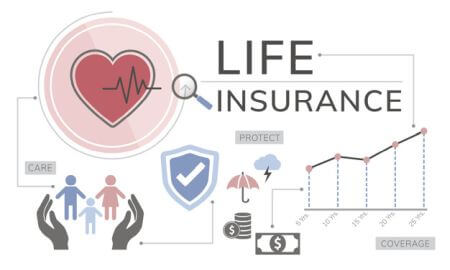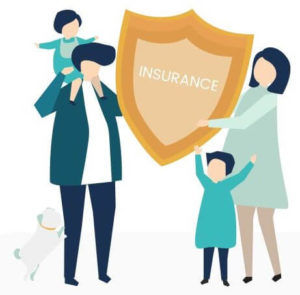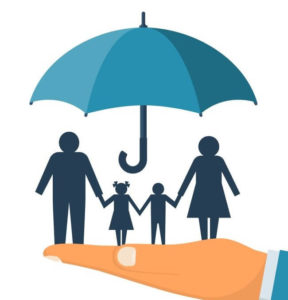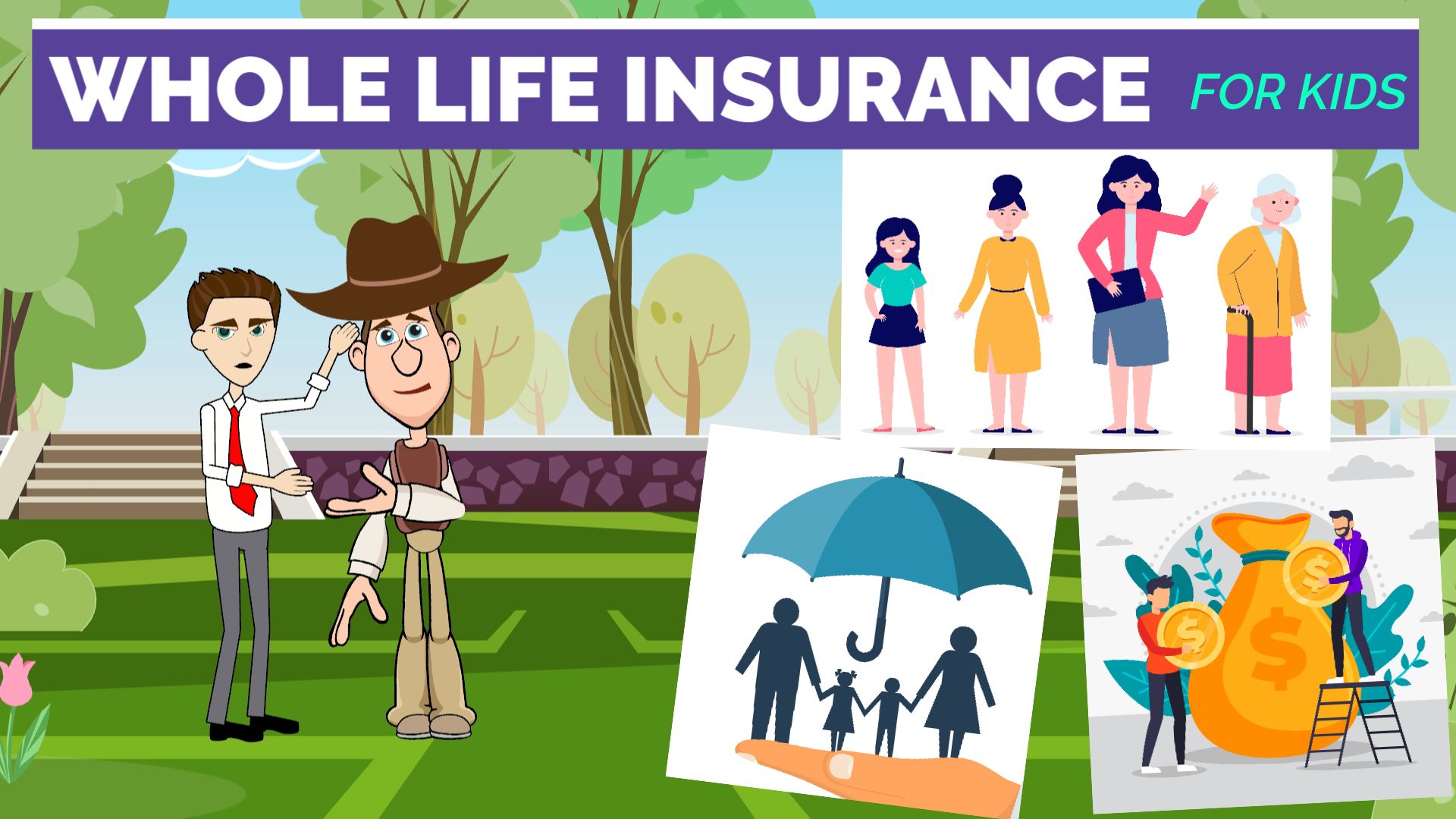Part 1: What is Whole Life Insurance
Part 2: Whole Life Insurance – Is it Right for You (Advantages and Disadvantages)
Introduction to Whole Life Insurance for Kids and Teens
This video explains the concept of Whole Life Insurance in a simple, concise way for kids and beginners. It could be used by kids & teens to learn about Whole Life Insurance, or used as a money & personal finance resource by parents and teachers as part of a Financial Literacy course or K-12 curriculum.

Suitable for students from grade levels:
- Elementary School
- Middle School
- High School
The topics covered are:
- What is whole life insurance
- How expensive is whole life insurance, and how is the premium decided
- Cash value in whole life insurance
- Pros / advantages of whole life insurance
- Cons / disadvantages of whole life insurance
- Is whole life insurance right for you – should you buy it
What is whole life insurance?
Whole life insurance is a type of permanent life insurance that guarantees payment of a pre-agreed amount, called the death benefit, to the beneficiaries stated in the policy, if the policyholder dies after buying the whole life insurance.

This is in exchange for periodic payments, called premium.
In addition to the death benefit, whole life insurance also has a savings component, called cash value, where money grows on a tax-advantaged basis.
How expensive is whole life insurance? And how is the premium decided?
Whole life insurance premiums can be anywhere from a few hundred dollars per month to upwards of a few thousand dollars per month. This is because the premium varies a lot based on different factors like age, gender, health, existing illnesses or disabilities, and the policy amount.
For example, Robert, a healthy 25 year old, who is covered for $100,000 will pay much lower premiums than Sally, who is 60, has an illness, and is covered for $300,000.
With whole life insurance, the premium is level – which means that it stays the same throughout the life of the policy holder.
Can you tell me a little more about the cash value?
A portion of the insurance premium you pay is set aside and becomes part of the policy’s cash value. This money then earns tax-deferred interest, at least a part of which is guaranteed. This allows the cash value to increase over time.
The cash component can be accessed by the policyholder during their lifetime as withdrawals or loans, as needed. For example, people can use this money as an emergency fund or to help them live in retirement.
However, the loans need to be paid back with interest, and any withdrawals or unpaid loans reduce the death benefit.
What are the advantages of whole life insurance?

One big advantage of whole life insurance is that it lasts for the entire life of the policyholder without the need for any renewal – unlike term life insurance.
It comes with a guaranteed payout to the beneficiaries as long as the premiums are paid.
Another benefit is that the premium is level (it does not increase), irrespective of the policyholder’s age or health condition.
Some whole life insurance policies may also pay out dividends that can be withdrawn or reinvested to increase the cash value or death benefit.
Another advantage is that it has a cash value that can serve as an emergency fund you can dip into if the need arises.
Are there any disadvantages of whole life insurance?
The biggest disadvantage of whole life insurance is its high premiums. Whole life insurance can be significantly more expensive than other types of life insurance.
Another huge yet often overlooked disadvantage is that the beneficiaries of these policies only receive the death benefit, and not the cash-value – any cash value goes back to the insurance company.
Also, if there are outstanding loans or withdrawals by the policyholder during their lifetime, the death benefit could be considerably reduced.
Is whole life insurance right for me? Should I buy it?
Whole life insurance is ideal for someone looking for lifelong coverage or is interested in the tax advantaged aspect of the cash component.

But, since whole life insurance is significantly more expensive than term life insurance, if you don’t need lifelong coverage or you are a disciplined investor who can make good investment choices, you can use a strategy called “buy term and invest the difference”.
Like the name suggests, you buy term life insurance instead of whole life insurance, and invest the money saved in premiums. This way, not only will you pay less for the insurance, but you will also be able to invest on your terms to maximize returns.
However, if you don’t consider yourself a savvy investor or think the cash value will give you peace of mind, it might be worth looking into whole life insurance.
Download Transcript: Ideal for Use by Teachers in their Lesson Plan to Teach Kids & Teens
Part 1: What is Whole Life Insurance
Part 2: Whole Life Insurance – Is it Right for You (Advantages and Disadvantages)
Podcast
Part 1: What is Whole Life Insurance
Fun, informative and concise episodes by a 10-year old, breaking down complex financial concepts in a way that kids and beginners can understand. Episodes cover personal finance topics like saving, investing, banking, credit cards, insurance, real estate, mortgage, retirement planning, 401k, stocks, bonds, income tax, and more, and are in the form of a conversation between a cowboy (a finance novice) and his friend, a stock broker. Making finance your friend, only at Easy Peasy Finance.
A little bit about me: I have been fascinated with the world of personal finance since I was 6! I love to read personal finance books, and keep myself updated on the latest by reading various personal finance magazines. My friends often ask me questions about finance because they find it complex and intimidating. That’s what inspired me to start my YouTube channel called Easy Peasy Finance when I was 8, and this podcast 2 years later.
Everything you need to know about Whole Life Insurance: What is whole life insurance, How expensive is whole life insurance, How is the premium calculated, Cash value in whole life insurance, and more. Show notes and transcript at: What is Whole Life Insurance? A Simple Explanation for Kids, Teens & Beginners Everything you need to …

Part 2: Whole Life Insurance – Is it Right for You (Advantages and Disadvantages)
Fun, informative and concise episodes by a 10-year old, breaking down complex financial concepts in a way that kids and beginners can understand. Episodes cover personal finance topics like saving, investing, banking, credit cards, insurance, real estate, mortgage, retirement planning, 401k, stocks, bonds, income tax, and more, and are in the form of a conversation between a cowboy (a finance novice) and his friend, a stock broker. Making finance your friend, only at Easy Peasy Finance.
A little bit about me: I have been fascinated with the world of personal finance since I was 6! I love to read personal finance books, and keep myself updated on the latest by reading various personal finance magazines. My friends often ask me questions about finance because they find it complex and intimidating. That’s what inspired me to start my YouTube channel called Easy Peasy Finance when I was 8, and this podcast 2 years later.
Everything you need to know before deciding to buy whole life insurance: advantages of whole life insurance, disadvantages of whole life insurance, is whole life insurance right for you – should you buy it, and more. Show notes and transcript at: What is Whole Life Insurance? A Simple Explanation for Kids, Teens & Beginners Everything …


